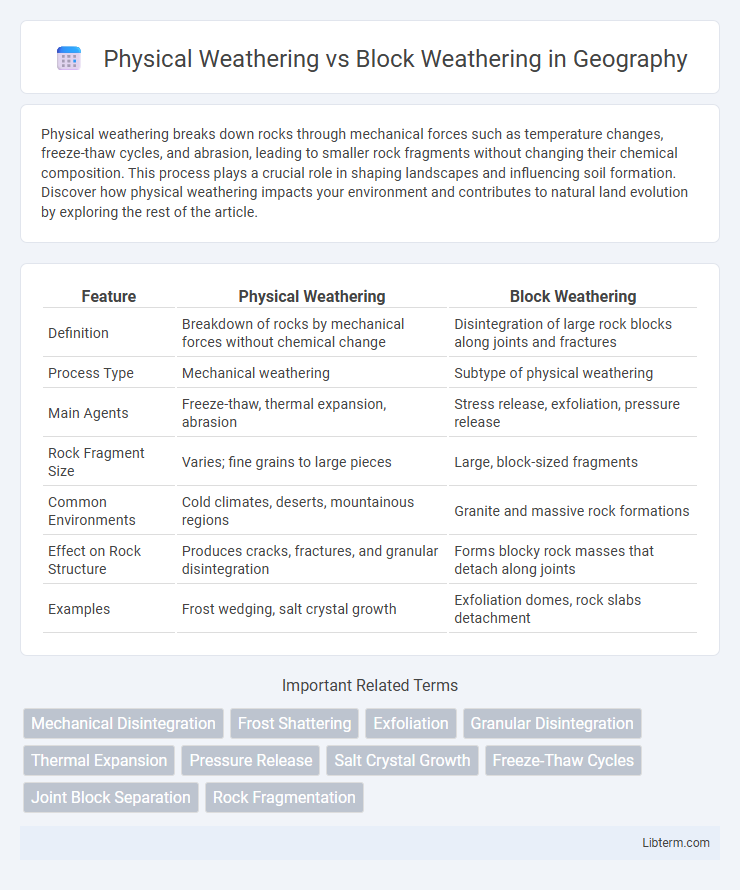Physical weathering breaks down rocks through mechanical forces such as temperature changes, freeze-thaw cycles, and abrasion, leading to smaller rock fragments without changing their chemical composition. This process plays a crucial role in shaping landscapes and influencing soil formation. Discover how physical weathering impacts your environment and contributes to natural land evolution by exploring the rest of the article.
Table of Comparison
| Feature | Physical Weathering | Block Weathering |
|---|---|---|
| Definition | Breakdown of rocks by mechanical forces without chemical change | Disintegration of large rock blocks along joints and fractures |
| Process Type | Mechanical weathering | Subtype of physical weathering |
| Main Agents | Freeze-thaw, thermal expansion, abrasion | Stress release, exfoliation, pressure release |
| Rock Fragment Size | Varies; fine grains to large pieces | Large, block-sized fragments |
| Common Environments | Cold climates, deserts, mountainous regions | Granite and massive rock formations |
| Effect on Rock Structure | Produces cracks, fractures, and granular disintegration | Forms blocky rock masses that detach along joints |
| Examples | Frost wedging, salt crystal growth | Exfoliation domes, rock slabs detachment |
Introduction to Weathering Processes
Physical weathering involves the mechanical breakdown of rocks into smaller pieces without changing their chemical composition, driven by factors like temperature fluctuations, freeze-thaw cycles, and abrasion. Block weathering, a subset of physical weathering, specifically refers to the separation of large, often rectangular rock masses along natural fractures or joints, influenced by stress release and temperature variations. Understanding these processes is crucial in geology for analyzing landscape evolution and rock stability.
Defining Physical Weathering
Physical weathering involves the mechanical breakdown of rocks into smaller fragments without changing their chemical composition, driven by processes such as freeze-thaw cycles, thermal expansion, and abrasion. Block weathering, a subtype of physical weathering, specifically causes large, angular blocks of rock to detach along natural joints and fractures. Understanding physical weathering is essential for analyzing landscape evolution and rock disintegration patterns, particularly in exposed geological formations.
What is Block Weathering?
Block weathering is a form of physical weathering where large rock masses break down into smaller, angular blocks along joints or fractures without chemical alteration. This process occurs primarily due to mechanical forces such as freeze-thaw cycles, thermal expansion, and pressure release, causing the rock to fracture and detach in coherent pieces. Unlike other types of physical weathering, block weathering emphasizes the fracturing of bedrock into discrete blocks rather than granular disintegration.
Key Mechanisms of Physical Weathering
Physical weathering primarily involves mechanical processes such as freeze-thaw cycles, thermal expansion, and abrasion that cause rock disintegration without chemical change. Freeze-thaw action occurs when water penetrates cracks, freezes, and expands, exerting pressure that fractures rock. Block weathering, a subset of physical weathering, involves the separation of rock masses along joints and fractures, often driven by stress relief and exfoliation.
Core Processes in Block Weathering
Block weathering primarily involves the mechanical breakdown of rock masses along pre-existing fractures, joints, and bedding planes due to pressure release and temperature fluctuations. Physical stresses such as freeze-thaw cycles cause expansion within cracks, leading to the detachment of large rock blocks from the parent material. This process contrasts with finer-scale physical weathering by emphasizing the separation of substantial, angular blocks driven by internal rock stresses.
Factors Influencing Physical Weathering
Physical weathering is primarily influenced by factors such as temperature fluctuations, freeze-thaw cycles, and mechanical forces like wind and water abrasion that cause rock disintegration without chemical change. The presence of moisture enhances freeze-thaw action, where water expands upon freezing, exerting pressure that fractures rock blocks, accelerating block weathering processes. Rock composition, joint density, and surface exposure further dictate the intensity and rate of physical weathering in various environments.
Environmental Conditions Favoring Block Weathering
Block weathering primarily occurs in environments with significant temperature fluctuations, causing expansion and contraction that fracture rock along existing joints. This process is most active in arid or semi-arid climates where mechanical stresses dominate over chemical weathering. Frost action and diurnal heating cycles intensify block disintegration, favoring the formation of angular rock blocks.
Comparative Analysis: Physical vs. Block Weathering
Physical weathering involves the mechanical breakdown of rocks into smaller particles without altering their chemical composition, often driven by processes like freeze-thaw cycles and thermal expansion. Block weathering, a subset of physical weathering, specifically refers to the fracturing of rocks along joints or fractures, resulting in the detachment of large, angular blocks. Compared to general physical weathering, block weathering typically produces larger rock fragments and is strongly influenced by the pre-existing structural weaknesses within the rock mass.
Real-World Examples and Case Studies
Physical weathering involves the mechanical breakdown of rocks through processes like freeze-thaw cycles, thermal expansion, and abrasion, commonly observed in mountainous regions such as the Rocky Mountains where temperature fluctuations cause rock fragmentation. Block weathering specifically refers to the disintegration of rock masses along joint planes, evident in granite outcrops like the tors of Dartmoor, UK, where block-shaped fragments detach due to stress release and exfoliation. Case studies from the Sierra Nevada highlight block weathering's role in shaping large granite domes, contrasting with the granular disintegration typical of physical weathering in sedimentary rock landscapes.
Conclusion: Impacts on Landscape Evolution
Physical weathering accelerates rock breakdown by mechanical forces, increasing surface area exposed to further erosion. Block weathering, characterized by the detachment of large rock blocks along joints and fractures, significantly shapes rugged terrains and influences slope stability. Together, these weathering processes drive landscape evolution by modifying landforms and controlling sediment distribution patterns.
Physical Weathering Infographic

 libterm.com
libterm.com